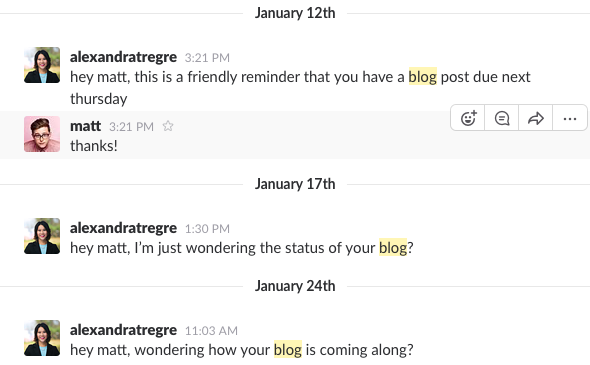In a world where content marketing is “king”, no one really wants to add to the noise.
As a user experience designer, the first question that comes to mind when presented with any challenge is: Why? Why is this happening, why do we want to solve this, why is this the best way of solving this problem?
The whys are the first of many questions. UX designers succeed or fail on the strength of their questions, whether they’re conducting user interviews, deciphering requirements, or negotiating details with clients.
In general, the UX designer’s objective is to identify the true root of a problem and devise an appropriate solution. So what happens when that problem has already been solved in more ways than you can count?
The challenge, in this case, is simple, and I have failed at it repeatedly for many months: “Please, Please Write Some Damn Content.”

Our overwhelmingly gracious and patient marketing department (hi Alex!) politely, but firmly encourages me to write some content that will help position our company as a thought leader (ie., content marketing). And there is also the peer-pressure-based urge to define a personal brand for future gain.
I struggle with the idea of creating more content because the need has already been filled – is being filled right now – by thousands of designers and design-adjacent writers, each sharing their own personal experiences to help others deal with tough situations, introduce newcomers to the standards and practices of UX, evaluate tools, to brag and boast and opine. It’s not a case of imposter syndrome — I’ve taught classes and mentored folks one-on-one, and it’s a deeply enriching experience. My problem is that it doesn’t seem like I’m solving a problem when similar content has already been written hundreds of times.
There are many online clearinghouses devoted to curating the flood of daily content, and I read several of them every day: Designer News, QBN and Product Hunt, among many others. There is an increasing sense of fatigue in some of these communities at the monotony of this content, an opinion I share, but at the same time, it’s hard to criticize authors for failing to communicate something new when so many UX/UI designers are working in very similar environments. It’s not wrong to write a listicle of useful sketch plugins, but it doesn’t feel good to know you’re just contributing noise instead of providing meaningful, innovative content.
As a UX designer, I already have an uncomfortable relationship with innovation; it’s exhilarating, but it’s also dangerous and demanding. UX designers rely heavily on established patterns to promote user comprehension (whether it’s the gospel of Apple’s HIG, Google’s Material Design Guidelines or the assembled wisdom of UX experts like Nielsen/Norman Group or Luke Wroblewski.
Especially for those working in an agency or consultancy environment with short timelines requiring constant rapid turnaround, innovative UX patterns are frequently too time-consuming to properly design and test. I’m very tempted to stick to the tricks that work just to get it done; for most products, an unremarkable and highly functional UI is a laudable goal.
So the idea of regurgitating stale content in the name of SEO isn’t unthinkable; it’s a practical, safe solution to a common problem.
But it feels wrong. Because I have a keen sense that the problem I’m solving isn’t a real problem. Critiques of content marketing or “big content” have been discussed at length in other forums — the negative effects of the 24-hour news cycle, the rise of BuzzFeed and junk content — but regardless of how you feel about it, it shapes our online world.
Related: How to Foster a Growth Mindset
So let’s restate the challenge: I need to generate interesting content that drives traffic, encourages brand engagement and builds my personal brand as an expert. (While not strictly required, it helps to be original, helpful, opinionated, and unique. 😉 )
But HOW
I found a solution by reframing the request and narrowing the scope of the audience down to one theoretical junior designer just starting out here at s|k.* Suddenly, writing became more intimate and meaningful — a one-on-one opportunity to help someone learn new processes and become comfortable in a new environment.
Once I rejected the idea of writing for the theoretical audience of ‘every designer,’ I first tried to write for myself. But I found the product too confessional and prone to tangents, and I rarely finished anything. Then I tried to write for no one — to generate functional, sterile process documentation that could be read by anyone, in any voice. It was very dull. Now that I’m experimenting with writing for an audience of one, writing is beginning to feel as enriching as a real conversation. And I feel as empowered as I would in real life to share my experiences without worrying about being redundant.
As a UX/UI designer, I find satisfaction in perfecting visual details and interactions many users won’t ever notice, so I take the small wins when I can get them. Writing for an audience of one isn’t a new concept by any means, but I found it helpful in adjusting my expectations and I hope it can help other designers in a similar position to stop worrying and just share what they know.
*I had some help from a useful blog piece on writing and its specific reference to Warren Buffet’s plain english handbook.
